paulie_walnuts
rookie of the year
- Joined
- Jul 12, 2019
- Posts
- 1,438
- Reputation
- 1,456
The Basic Question
One of the most puzzling questions about male pattern baldness that until recently has remained unanswered has been: Why does hair loss afflict us in the Norwood pattern?
Here, as we know it, is the Norwood pattern:
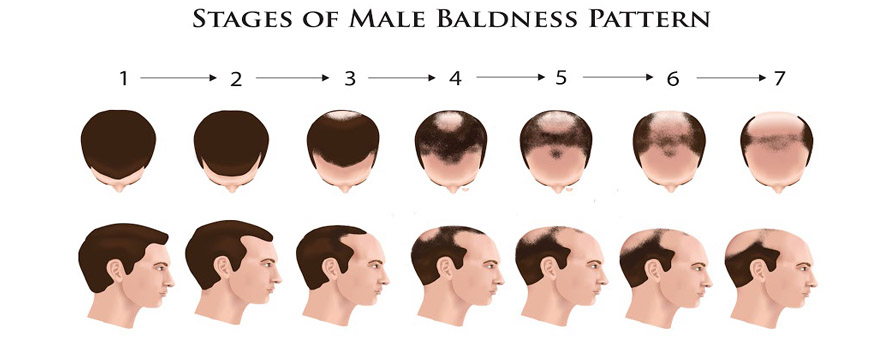
Hair loss begins at the corners, temples, and crown. Little by little it spreads from these points until the entire top of the head is bald.
For years, scientists have puzzled over the distribution and mechanics of androgenic hair loss as it pertains to scalp anatomy:
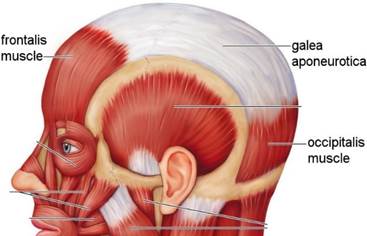
If you look at the basic structure of the head, you will notice a simple difference between balding areas and nonbalding areas:
Balding areas overlie the galea, while nonbalding areas (the NW7 horseshoe) overlie scalp muscles.
The galea aponeurotica (GA) is a fibrous band of connective tissue that connects to numerous scalp muscles. Recent research suggests that the galea is the fundamental cause of male (and female) pattern baldness.
How the Galea Causes Hair Loss
In simple terms, the galea is a site of constant mechanical stress from the muscles that attach to it. This mechanical stress is transmitted to the hair follicles which are attached to it. Mechanical stress triggers epigenetic changes to the hair follicles, which may begin even from the scalp's first development.
An androgenic and inflammatory cascade is eventually triggered as a result of this chronic mechanical tension. Androgen sensitivity genes, androgen receptor genes, and 5-alpha reductase enzymes are upregulated. This cascade causes DHT to accumulate over the galea, which then impairs blood supply, stimulates fibrosis, and miniaturizes hairs, causing baldness to occur.
Androgens are absolutely a critical part of the balding process. But they are thus secondary to the galea in explaining how areas of high and low androgen sensitivity are established and how the inflammatory cascade is triggered.
Mechanical Stress & the Galea
To figure this out, researchers performed Finite Element Analysis, which is a common technique used in mechanical engineering to predict mechanical stresses, eg. for predicting how engine parts or buildings will hold up under stress. Using this technique, they 3D-modeled the scalp and the direction of tension which should be exerted on it by the muscles.
When they studied the tension distribution that resulted, it matched the Norwood pattern, where areas of high stress bald first (corners and crown), and areas of low stress bald last.
Here is a graphical representation of their final finding. The picture on the left is their result. The picture on the right is the standard Norwood pattern. As you can see, they match very well.
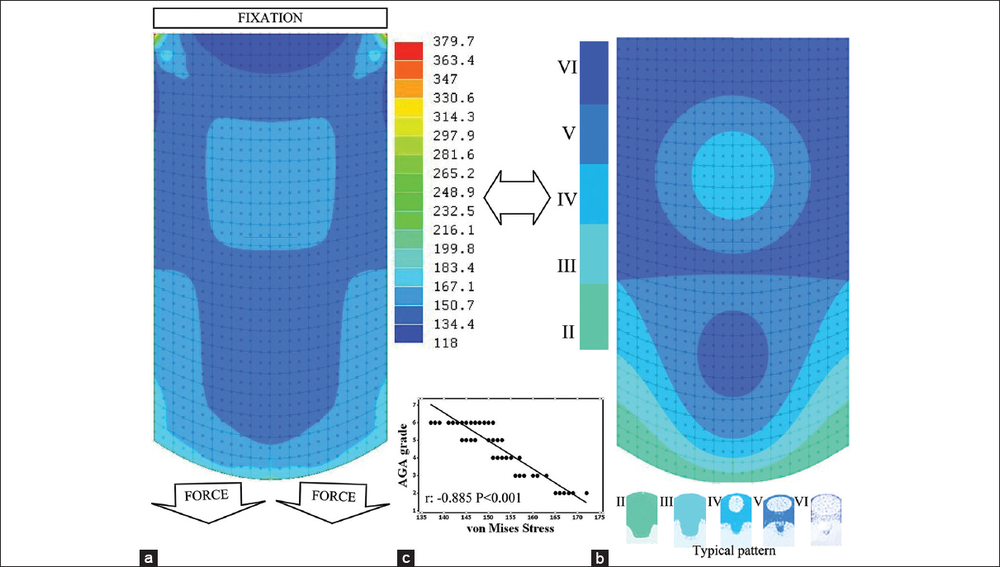
(ref)
How Mechanical Stress Leads to Androgenic Baldness
Hair overlying the galea is unique in that the skin from which it grows is mechanically "fused" to the galea, with only a negligibly thin layer of subcutaneous fat cushioning it between:
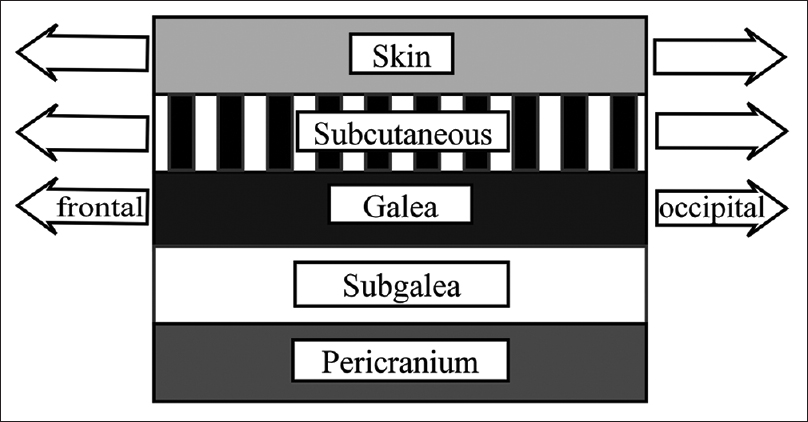
Not only is this layer of subcutaneous fat quite thin, it atrophies with age. It has been theorized that age-related subcutaneous atrophy may in fact partly be the mechanism by which the balding process "kicks in" at a certain age for different men. (ref) Alternatively, the date of first balding might be pre-determined by the degree to which androgen sensitivity genes are induced by galeal stress during early development.
With minimal cushioning, mechanical stresses that are exerted through the galea are easily transmitted into the skin from which the hair follicles grow.
Integrins, which are proteins that sense mechanical stress, are triggered by the stress, and through chemical mediators, genes are activated in response to stress to accomplish several undesirable things:
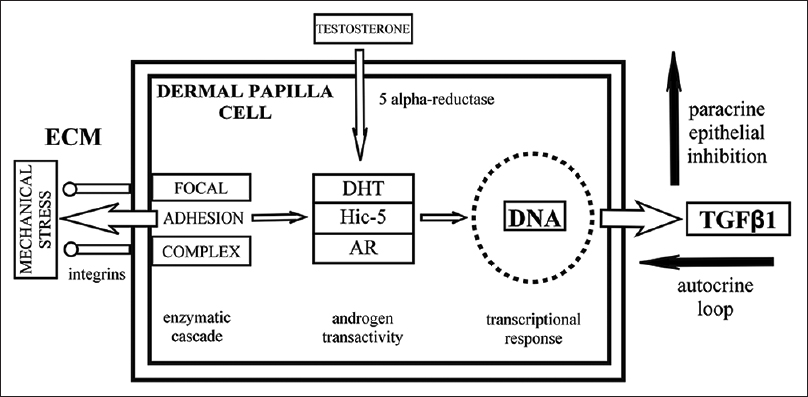 (ref)
(ref)
Once DHT and androgen sensitivity have been triggered in this manner, Norwood pattern miniaturization can then proceeds via three primary mechanisms: dermal sheath thickening, perifollicular fibrosis, and calcification. These processes remodel the tissues – restricting follicle growth space, oxygen, and nutrient supply – leading to the slow, persistent hair follicle miniaturization of androgenic alopecia. (ref)
How Hair Medications/Treatments Can Disrupt This Process
Understanding this cascade, we can then conceptualize our conventional treatments depending on where they intervene.
Why Some Men Do Not Bald
Some men, as we know, are simply not prone to balding, and despite likely similar galeal stress, their hair remains pristine with age. Men who do not bald (or are more naturally resistant to balding) within this model can be explained in two possible ways:
(1) Their subcutaneous connective tissue and/or their skin and hair follicles are mechanically structured in a different way from balding men, such that mechanical stress from the galea is not transmitted to the hair follicles and they are thus protected from this stress.
(2) Their hair follicles and dermal papilla cells are genetically resistant to the mechanical stress from the galea, and this stress simply does not induce the same epigenetic changes or inflammatory and androgenic cascade that it does in balding-prone men.
Unfortunately, both of these possible explanations provide us little help, as they are both reliant on genetic differences that are likely pre-ordained from the time of conception.
Hair Transplantation and the Concept of "DHT-Resistance"
Hair from the NW7 zone (ie. outside the galea) is generally described as "DHT-resistant". This "DHT resistance" can be conceptualized to occur in this model as a result of these hairs growing and developing over a life time in an area of the scalp which is free of galeal tension.
By developing in areas without tension, these follicles would be expected to have considerably downregulated genes for androgen sensitivity, androgen receptors, and 5-alpha reductase. This type of downregulation is termed epigenetic change, where due to environmental/developmental factors, these hairs have now become less prone to expressing genes associated with these issues. Those genes have been mostly "turned off".
Some people believe that hair transplants, as long as they are taken from the NW7 zone, should be expected to last for life once transplanted, even in the absence of medications like finasteride. Others believe that if we quantitatively follow these transplanted hairs for decades, we might see them start to miniaturize over time, once they are placed over the galea and newly subjected to its stresses.
Primarily, we would need to understand how quickly after donor zone to galea transplantation, and if at all, the good epigenetic changes induced by developing in the "safe zone" can be undone and epigenetic changes induced by the galeal stress can be manifested. Transplantation studies (ref, ref) would suggest most of the epigenetic differences dictating stress and androgen sensitivity between galeal vs. nongaleal skin are set very early in life, and these switches may be permanent once set, so the protection donor hair gets from developing in a tension free zone may last a lifetime regardless of where or if it is moved.
However, the researchers I have cited above have suggested that we need good, decades long studies on the fate of transplanted hairs in human scalps to be clear.
Therapies Attempting to Induce DHT Resistance
Some of the new therapies that are being developed are based on the principle of trying to induce "DHT resistance" to galeal hair follicles by transferring dermal papilla cells from the NW7 zone to them.
It will take decades to see if that "DHT-resistance" holds after years of new stress from the galea. Again, this will depend on the degree to which the positive epigenetic programming our NW7 donor hair gets can retain permanence once the galeal stress begins to exert its pressure on these cells.
Why Female Pattern Hair Loss Looks Slightly Different
Although most site members are male, we do have some women, and I think it's interesting to comment on gender differences in the hair loss pattern within this model.
Female pattern androgenic hair loss follows the Ludwig Pattern. Like with men, this involves balding of the entire galeal region, but with the unique characteristics that it usually starts at the top center of the head and the frontal hairline is usually preserved until the very end:

The differences in balding distribution can likely explained by two factors.
Firstly, the shape of a woman's head is expected to be different on average from that of a man's, which might lead to different galeal tension patterns. These patterns might be expected to favor the top of the head where many women first notice their loss, rather than the crown, as in men. This would need to be confirmed by further Finite Element Analysis.
Second, and more importantly, women are known to have high levels of aromatase in their frontotemporal scalp. (ref) Aromatase converts testosterone into estrogen. Thus the aromatase in these areas helps protect women's frontal hairlines, corners, and temple points until the very end by clearing out some of the androgen (testosterone) that would otherwise accumulate from galeal stress and damage these hairs.
We know this frontotemporal aromatase is the primary explanation for the gender difference in patterns, as when women are treated with aromatase inhibitors, they develop male pattern (ie. Norwood pattern) hair loss. (ref)
Conclusions
We can therefore understand that although androgens are a critical component of the hair loss process, the problems we experience due to them are initially triggered by galeal tension patterns in the scalp.
On a practical level, this does not change too much in terms of how we should all be treating our hair loss. But I think it's important to understand. It answers a question that has puzzled our species for at least centuries. Furthermore, this understanding can help us better assess possible treatments and therapies and have realistic goals about what is or isn't possible.
Primarily it suggests that at least with current technology, no "simple one time cure" for male pattern or female pattern androgenic hair loss can likely easily exist, and for any of us facing this problem in our teens, 20s, or early 30s, it may likely be a lifelong battle to keep under control. If therapies to confer DHT resistance prove successful and resistant to being undone by the galea, then perhaps it will get easier.
I have always strongly believed people should not wait around for a magic "cure", but rather make practical compromises, and treat the problem with the best agents we have available today.
Fortunately, there have never before been as many agents available for interrupting the hair loss cascade, so we all have plenty of options. Hopefully we'll get better genetic or stem cell therapies in the long run, but until then, as always, it would likely be wise to try to preserve as much hair as is possible.
One of the most puzzling questions about male pattern baldness that until recently has remained unanswered has been: Why does hair loss afflict us in the Norwood pattern?
Here, as we know it, is the Norwood pattern:
Hair loss begins at the corners, temples, and crown. Little by little it spreads from these points until the entire top of the head is bald.
For years, scientists have puzzled over the distribution and mechanics of androgenic hair loss as it pertains to scalp anatomy:
If you look at the basic structure of the head, you will notice a simple difference between balding areas and nonbalding areas:
Balding areas overlie the galea, while nonbalding areas (the NW7 horseshoe) overlie scalp muscles.
The galea aponeurotica (GA) is a fibrous band of connective tissue that connects to numerous scalp muscles. Recent research suggests that the galea is the fundamental cause of male (and female) pattern baldness.
How the Galea Causes Hair Loss
In simple terms, the galea is a site of constant mechanical stress from the muscles that attach to it. This mechanical stress is transmitted to the hair follicles which are attached to it. Mechanical stress triggers epigenetic changes to the hair follicles, which may begin even from the scalp's first development.
An androgenic and inflammatory cascade is eventually triggered as a result of this chronic mechanical tension. Androgen sensitivity genes, androgen receptor genes, and 5-alpha reductase enzymes are upregulated. This cascade causes DHT to accumulate over the galea, which then impairs blood supply, stimulates fibrosis, and miniaturizes hairs, causing baldness to occur.
Androgens are absolutely a critical part of the balding process. But they are thus secondary to the galea in explaining how areas of high and low androgen sensitivity are established and how the inflammatory cascade is triggered.
Mechanical Stress & the Galea
To figure this out, researchers performed Finite Element Analysis, which is a common technique used in mechanical engineering to predict mechanical stresses, eg. for predicting how engine parts or buildings will hold up under stress. Using this technique, they 3D-modeled the scalp and the direction of tension which should be exerted on it by the muscles.
When they studied the tension distribution that resulted, it matched the Norwood pattern, where areas of high stress bald first (corners and crown), and areas of low stress bald last.
Here is a graphical representation of their final finding. The picture on the left is their result. The picture on the right is the standard Norwood pattern. As you can see, they match very well.
(ref)
How Mechanical Stress Leads to Androgenic Baldness
Hair overlying the galea is unique in that the skin from which it grows is mechanically "fused" to the galea, with only a negligibly thin layer of subcutaneous fat cushioning it between:
Not only is this layer of subcutaneous fat quite thin, it atrophies with age. It has been theorized that age-related subcutaneous atrophy may in fact partly be the mechanism by which the balding process "kicks in" at a certain age for different men. (ref) Alternatively, the date of first balding might be pre-determined by the degree to which androgen sensitivity genes are induced by galeal stress during early development.
With minimal cushioning, mechanical stresses that are exerted through the galea are easily transmitted into the skin from which the hair follicles grow.
Integrins, which are proteins that sense mechanical stress, are triggered by the stress, and through chemical mediators, genes are activated in response to stress to accomplish several undesirable things:
- Androgen receptor production is increased, making the hair cells more sensitive to androgens
- Androgen sensitivity cofactors are increased, further increasing androgen sensitivity
- 5-alpha reductase production is increased, leading to more production and accumulation of DHT
- Androgens upregulate production of transforming growth factor β-1 (TGFβ-1), causing scalp fibrosis
- Androgens inflame the hair follicles in a feedback loop, causing them to progressively miniaturize over time
Once DHT and androgen sensitivity have been triggered in this manner, Norwood pattern miniaturization can then proceeds via three primary mechanisms: dermal sheath thickening, perifollicular fibrosis, and calcification. These processes remodel the tissues – restricting follicle growth space, oxygen, and nutrient supply – leading to the slow, persistent hair follicle miniaturization of androgenic alopecia. (ref)
How Hair Medications/Treatments Can Disrupt This Process
Understanding this cascade, we can then conceptualize our conventional treatments depending on where they intervene.
- Botox - Supporting this model, scalp Botox relieves mechanical stress on the galea and has been shown to increase hair by 18% after one year, on par with finasteride. (ref)
- 5-Alpha Reductase Inhibitors - Drugs like finasteride and dutasteride, as well as newer experimental agents like R-equol (see here), can reduce the activity of 5-AR to reduce DHT production. By blocking the DHT from being made, we can disrupt the inflammatory cascade at this level, and the mechanical stress no longer will result in hair loss.
- Androgen Receptor Antagonists - Drugs like cyproterone, spironolactone, flutamide, & darolutamide work by blocking androgen receptors in the hairs, thus preventing testosterone & DHT from binding. If androgens can't bind to the receptors, again the inflammatory cascade is aborted and hair is preserved.
- Anti-Histamines - Topical cetirizine or desloratadine can block production of a wide range of downstream inflammatory mediators which are triggered by androgens binding to androgen receptors.
- PGD2 Inhibitors - Similarly, the newer PGD2 inhibitors like setipiprant/fevipiprant are proposed to be possibly useful for hair loss as they block PGD2 which is a downstream inflammatory mediator provoked by androgen binding.
Why Some Men Do Not Bald
Some men, as we know, are simply not prone to balding, and despite likely similar galeal stress, their hair remains pristine with age. Men who do not bald (or are more naturally resistant to balding) within this model can be explained in two possible ways:
(1) Their subcutaneous connective tissue and/or their skin and hair follicles are mechanically structured in a different way from balding men, such that mechanical stress from the galea is not transmitted to the hair follicles and they are thus protected from this stress.
(2) Their hair follicles and dermal papilla cells are genetically resistant to the mechanical stress from the galea, and this stress simply does not induce the same epigenetic changes or inflammatory and androgenic cascade that it does in balding-prone men.
Unfortunately, both of these possible explanations provide us little help, as they are both reliant on genetic differences that are likely pre-ordained from the time of conception.
Hair Transplantation and the Concept of "DHT-Resistance"
Hair from the NW7 zone (ie. outside the galea) is generally described as "DHT-resistant". This "DHT resistance" can be conceptualized to occur in this model as a result of these hairs growing and developing over a life time in an area of the scalp which is free of galeal tension.
By developing in areas without tension, these follicles would be expected to have considerably downregulated genes for androgen sensitivity, androgen receptors, and 5-alpha reductase. This type of downregulation is termed epigenetic change, where due to environmental/developmental factors, these hairs have now become less prone to expressing genes associated with these issues. Those genes have been mostly "turned off".
Some people believe that hair transplants, as long as they are taken from the NW7 zone, should be expected to last for life once transplanted, even in the absence of medications like finasteride. Others believe that if we quantitatively follow these transplanted hairs for decades, we might see them start to miniaturize over time, once they are placed over the galea and newly subjected to its stresses.
Primarily, we would need to understand how quickly after donor zone to galea transplantation, and if at all, the good epigenetic changes induced by developing in the "safe zone" can be undone and epigenetic changes induced by the galeal stress can be manifested. Transplantation studies (ref, ref) would suggest most of the epigenetic differences dictating stress and androgen sensitivity between galeal vs. nongaleal skin are set very early in life, and these switches may be permanent once set, so the protection donor hair gets from developing in a tension free zone may last a lifetime regardless of where or if it is moved.
However, the researchers I have cited above have suggested that we need good, decades long studies on the fate of transplanted hairs in human scalps to be clear.
Therapies Attempting to Induce DHT Resistance
Some of the new therapies that are being developed are based on the principle of trying to induce "DHT resistance" to galeal hair follicles by transferring dermal papilla cells from the NW7 zone to them.
It will take decades to see if that "DHT-resistance" holds after years of new stress from the galea. Again, this will depend on the degree to which the positive epigenetic programming our NW7 donor hair gets can retain permanence once the galeal stress begins to exert its pressure on these cells.
Why Female Pattern Hair Loss Looks Slightly Different
Although most site members are male, we do have some women, and I think it's interesting to comment on gender differences in the hair loss pattern within this model.
Female pattern androgenic hair loss follows the Ludwig Pattern. Like with men, this involves balding of the entire galeal region, but with the unique characteristics that it usually starts at the top center of the head and the frontal hairline is usually preserved until the very end:
The differences in balding distribution can likely explained by two factors.
Firstly, the shape of a woman's head is expected to be different on average from that of a man's, which might lead to different galeal tension patterns. These patterns might be expected to favor the top of the head where many women first notice their loss, rather than the crown, as in men. This would need to be confirmed by further Finite Element Analysis.
Second, and more importantly, women are known to have high levels of aromatase in their frontotemporal scalp. (ref) Aromatase converts testosterone into estrogen. Thus the aromatase in these areas helps protect women's frontal hairlines, corners, and temple points until the very end by clearing out some of the androgen (testosterone) that would otherwise accumulate from galeal stress and damage these hairs.
We know this frontotemporal aromatase is the primary explanation for the gender difference in patterns, as when women are treated with aromatase inhibitors, they develop male pattern (ie. Norwood pattern) hair loss. (ref)
Conclusions
We can therefore understand that although androgens are a critical component of the hair loss process, the problems we experience due to them are initially triggered by galeal tension patterns in the scalp.
On a practical level, this does not change too much in terms of how we should all be treating our hair loss. But I think it's important to understand. It answers a question that has puzzled our species for at least centuries. Furthermore, this understanding can help us better assess possible treatments and therapies and have realistic goals about what is or isn't possible.
Primarily it suggests that at least with current technology, no "simple one time cure" for male pattern or female pattern androgenic hair loss can likely easily exist, and for any of us facing this problem in our teens, 20s, or early 30s, it may likely be a lifelong battle to keep under control. If therapies to confer DHT resistance prove successful and resistant to being undone by the galea, then perhaps it will get easier.
I have always strongly believed people should not wait around for a magic "cure", but rather make practical compromises, and treat the problem with the best agents we have available today.
Fortunately, there have never before been as many agents available for interrupting the hair loss cascade, so we all have plenty of options. Hopefully we'll get better genetic or stem cell therapies in the long run, but until then, as always, it would likely be wise to try to preserve as much hair as is possible.

